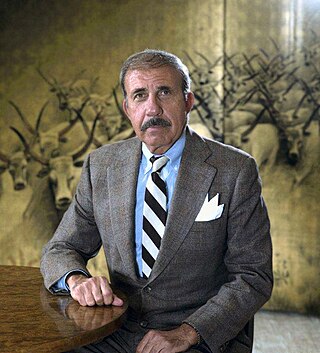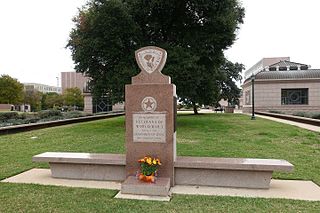
Lyndon Baines Johnson, often referred to by his initials LBJ, was an American politician who served as the 36th president of the United States from 1963 to 1969. He became president after the assassination of John F. Kennedy, under whom he had served as the 37th vice president from 1961 to 1963. A Democrat from Texas, Johnson also served as a U.S. representative and U.S. senator.

The Texas State Capitol is the capitol and seat of government of the American state of Texas. Located in downtown Austin, Texas, the structure houses the offices and chambers of the Texas Legislature and of the Governor of Texas. Designed in 1881 by architect Elijah E. Myers, it was constructed from 1882 to 1888 under the direction of civil engineer Reuben Lindsay Walker. A $75 million underground extension was completed in 1993. The building was added to the National Register of Historic Places in 1970 and recognized as a National Historic Landmark in 1986.

The California State Capitol Museum consists of a museum in and grounds around the California State Capitol in Sacramento, California, United States. The building has been the home of the California State Legislature since 1869. The State Capitol Museum has been a property in the California State Parks system since 1982.

The Lyndon Baines Johnson Library and Museum, also known as the LBJ Presidential Library, is the presidential library and museum of Lyndon Baines Johnson, the 36th president of the United States (1963–1969). It is located on the grounds of the University of Texas at Austin, and is one of 13 presidential libraries administered by the National Archives and Records Administration. The LBJ Library houses 45 million pages of historical documents, including the papers of President Johnson and those of his close associates and others.

Lyndon B. Johnson National Historical Park is a United States National Historical Park in central Texas about 50 miles (80 km) west of Austin in the Texas Hill Country. The park protects the birthplace, home, ranch, and grave of Lyndon B. Johnson, 36th president of the United States. During Johnson's administration, the LBJ Ranch was known as the Texas White House because the President spent approximately 20% of his time in office there.

Pompeo Luigi Coppini was an Italian born sculptor who emigrated to the United States. Although his works can be found in Italy, Mexico and a number of U.S. states, the majority of his work can be found in Texas. He is particularly famous for the Alamo Plaza work, Spirit of Sacrifice, a.k.a. The Alamo Cenotaph, as well as numerous statues honoring Texan figures, such as Lawrence Sullivan Ross, the fourth President of Texas A&M University.
Confederate monuments and memorials in the United States include public displays and symbols of the Confederate States of America (CSA), Confederate leaders, or Confederate soldiers of the American Civil War. Many monuments and memorials have been or will be removed under great controversy. Part of the commemoration of the American Civil War, these symbols include monuments and statues, flags, holidays and other observances, and the names of schools, roads, parks, bridges, buildings, counties, cities, lakes, dams, military bases, and other public structures. In a December 2018 special report, Smithsonian Magazine stated, "over the past ten years, taxpayers have directed at least $40 million to Confederate monuments—statues, homes, parks, museums, libraries, and cemeteries—and to Confederate heritage organizations."

Harry Joseph Middleton Jr. was an American journalist, author, and library director who served as Lyndon B. Johnson's Presidential speech writer and staff assistant from 1967 to 1969. Middleton was also director of the Lyndon Baines Johnson Library and Museum from 1971 until 2002, and led the Lyndon Baines Johnson Foundation from 1993 until 2004.
Armando Garcia Hinojosa is an artist and educator from Laredo, Texas, who is known for some half dozen major pieces of sculpture, including the massive Tejano Monument on the south lawn of the Texas State Capitol in Austin. The 12-piece monument was unveiled in the spring of 2012.

There are more than 160 monuments and memorials to the Confederate States of America and associated figures that have been removed from public spaces in the United States, all but five of which have been since 2015. Some have been removed by state and local governments; others have been torn down by protestors.

The Disabled American Veterans of Texas Monument is an outdoor memorial commemorating Texan veterans who were disabled while serving in the United States military services, installed on the Texas State Capitol grounds in Austin, Texas, in 1980. The monument's base is made from Texas Sunset Red Granite, and features inscriptions and the bronze seal of the Disabled American Veterans.

The Heroes of the Alamo Monument is an outdoor memorial commemorating those who fought and died during the Battle of the Alamo, installed on the Texas State Capitol grounds, in Austin, Texas, United States. It was designed by J.S. Clark, sculpted by Crohl Smith, and erected in 1891. The monument features a Texas Sunset Red Granite base topped by a bronze statue of a Texan carrying a muzzle-loading rifle. Among the names inscribed in the base's supports are James Bowie, David Crockett, and William B. Travis.

The Korean War Veterans Memorial is an outdoor monument by Edward L. Hankey commemorating the more than 289,000 Texans who served in the Korean War, installed on the Texas State Capitol grounds, in Austin, Texas, United States. The memorial was erected in 1999 by the Texas Lone Star Chapter of the Korean War Veterans Association. It features a star-shaped Texas Sunset Red Granite pedestal topped with a bronze sculpture of an eagle.

The Tejano Monument is a memorial commemorating the impact of Tejanos on Texas culture and history, installed on the Texas State Capitol grounds in Austin, Texas, United States. The monument was sculpted by Armando Hinojosa and erected by Tejano Monument, Inc. in 2012. It features nine life-size bronze statues on a 275-ton Texas Sunset Red Granite base, and five plaques describing Tejano history.

The Veterans of the 36th Infantry, Texas National Guard Monument is an outdoor memorial commemorating soldiers of the 36th Infantry, Texas National Guard, installed on the Texas State Capitol grounds in Austin, Texas, United States. The monument, designed by an unknown artist, was erected in 1959. It is made of Texas Sunset Red Granite and features the unit's "T-Patch" shoulder insignia.

The World War I Monument is an outdoor memorial commemorating veterans of World War I, installed on the Texas State Capitol grounds in Austin, Texas, United States. The Texas Sunset Red Granite monument was erected by members of the Department of Texas, Veterans of Foreign Wars in 1961. The artist, whose name is engraved at the base of the monument, is Joe Machac. It lists the barracks and auxiliaries that worked to create the memorial.














